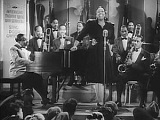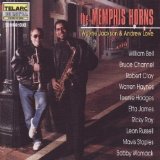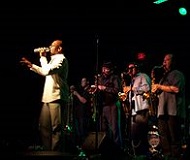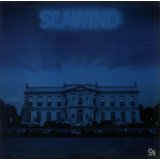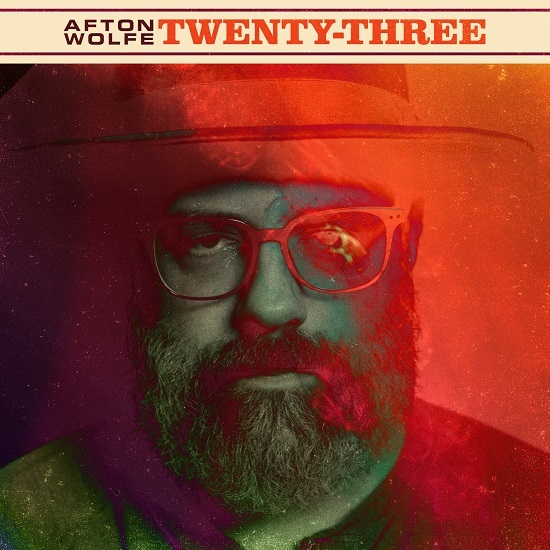
EP or mini album? My money would be on extended EP, but the way music’s distributed and consumed these days, it’s a moot point. Anyhow, Afton Wolfe has pulled together five songs, four of which have been released previously in a digital format and one new piece, ‘Cry’, which was written in response to a close friend’s personal tragedy.
Afton Wolfe is one of those rare artists that sound equally at home in three musical styles with similar roots; blues, soul and country and ‘Twenty-Three’ has references to all of these styles across its five tracks. And you couldn’t truly represent without having a triple-time song; ‘The Moon Is Going Down’ is a slow waltz with a very sparse arrangement and some lovely sax fills underpinning a gravelly vocal. The piano part of ‘Truck Drivin’ Man’ hints at The Doors with a densely-packed arrangement and a counterpoint lead vocal late in the song, while ‘So Purple’ is driven along by a deep bass guitar creating a Southern groove as Afton tells a story of incompatibility using imagery from mixing coloured lights or pigments – red and blue are almost at opposite ends of the spectrum (cold and warm), but they combine to create purple, and who wouldn’t want to be purple? ‘Late Nite Radio’ has a slow country feel with several tempo changes (up and down) to represent the progress of the journey and the busy finale, going out on a lonesome saxophone.
‘Cry’, which is the only entirely new song featured here, is a tour de force. The song is in the classic Stax/Atlantic Southern soul style (you can imagine Otis Redding or Bill Withers wrapping their vocal cords around this one). It’s a powerful slow soul ballad punctuated by Stax-style brass that allows Afton to demonstrate a powerful raw vocal delivery that conveys a sense a deeply felt sense of loss. It’s classic old soul.
The five songs on ‘Twenty-Three’ (I’m not getting into the mystical stuff around the title) are a great demonstration of the breadth of Afton Wolfe’s songwriting and vocal talents. You should give it a listen, and while you’re at it, check out his debut from two years ago, ‘Kings for Sale’. While you’re here, have a look at the video for the incredibly evocative ‘Late Nite Radio’:
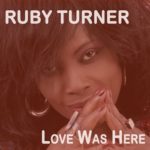 Twenty albums in twenty years; that’s not bad going, particularly when you have a day job fronting up for Jools Holland’s Rhythm and Blues Orchestra. You probably know that Ruby Turner has a fabulous voice, but she’s much more than the chanteuse with Jools Holland; Ruby Turner is a genuine British soul phenomenon with a career stretching back into the mid-eighties and some astonishing live and recorded performances (if you haven’t already heard it, check out her version of “Stay With Me Baby”). So, what’s the deal with Ruby’s latest album, “Love Was Here”?
Twenty albums in twenty years; that’s not bad going, particularly when you have a day job fronting up for Jools Holland’s Rhythm and Blues Orchestra. You probably know that Ruby Turner has a fabulous voice, but she’s much more than the chanteuse with Jools Holland; Ruby Turner is a genuine British soul phenomenon with a career stretching back into the mid-eighties and some astonishing live and recorded performances (if you haven’t already heard it, check out her version of “Stay With Me Baby”). So, what’s the deal with Ruby’s latest album, “Love Was Here”?
A couple of things; this is mainly about Ruby recognising the influence of the people she listened to as she grew up and trying to create the feel and grooves of those artists without creating carbon copies. The second thing is that Ruby has pulled together a fabulous soul band (mainly from Sheffield, a very fertile ground for British soul musicians). The band is: Kat Eaton (backing vocals), Nick Atkinson (guitars), Joe Glossop (keys), Jeremy Meek (bass) and John Blease (percussion) – Google any one of them and see just who they’ve worked with. This is a quality outfit, and they do what quality outfits do; they create arrangements that support the song and the vocal perfectly without any fuss or showboating.
The songwriting team is Kat Eaton and Nick Atkinson and between them they pull off the very clever trick of creating a groove and style that suggests a particular artist while still sounding fresh and original. Of course they have a huge advantage in that the songs are being delivered by one of the UK’s finest soul voices. The songs and the arrangements pull in structural elements from the styles they’re emulating; there are a lot of examples of the old gospel technique of call and response, not just with vocals but also between instruments as well. The other technique that appears a lot is unison playing in various instrumental configurations.
You can listen to the songs yourself and work out which song is influenced by which musical hero; there are nods in the direction of Al Green, Curtis Mayfield, BB King and Ry Cooder mentioned in the sleeve notes but you’ll also find references to Marvin Gaye, Sam Cooke and Otis Redding (and probably many more if you dig deep enough). It’s a fitting tribute to the pioneers of soul.
“Love Was Here” actually started life as an EP with four or five songs, but gradually grew to full album status over a period of eighteen months. The songs hang together well and it’s generally a coherent piece of work, apart from the bonus track “Chasing Love” from the film “The Host”. It’s the only song that wasn’t recorded at The Foundry in Sheffield and it’s very different, featuring a haunting solo violin and orchestral backing. It’s not better or worse than the other ten songs; it’s just very different.
“Love was Here” is the sound of great musicians lovingly evoking their musical influences, fronted up by a great British soul voice and it’s out now.
 A producer, a photographer and two musicians walk into a pub. Sorry, there isn’t a punchline to this; it’s just what happened. A quick pre-Christmas beer with some music business friends to chew the fat; what do you think we talked about? As always with these semi-unplanned sessions something good came out of it. We’ll leave it to Graeme Wheatley, bass player and songwriter with the band Deep Blue Sea to tell the story, enhancing it with some music trivia. You might want to start this piece whenyou have about an hour to spare because it’s a bit addictive, especially after Riot Towers made a contribution,
A producer, a photographer and two musicians walk into a pub. Sorry, there isn’t a punchline to this; it’s just what happened. A quick pre-Christmas beer with some music business friends to chew the fat; what do you think we talked about? As always with these semi-unplanned sessions something good came out of it. We’ll leave it to Graeme Wheatley, bass player and songwriter with the band Deep Blue Sea to tell the story, enhancing it with some music trivia. You might want to start this piece whenyou have about an hour to spare because it’s a bit addictive, especially after Riot Towers made a contribution,
Sitting in The New Cross House pub the other night with Allan McKay (something that could very easily become habit forming), we were talking about his series of guest articles “High Fives” in Music Riot – sign up now if ya haven’t already!
I’ve written a few before and always like rambling on about whatever, so I was happy to quickly volunteer to write one for this Christmas – even before Allan gave me my first pressie of the year – even if I had no idea what to waffle on about.
We were with Iago Banet, a guitarist from a band that I’ve heard are not that bad and we were talking about a gig we did a few weeks ago. Our singer, Dre Smith, had lost her voice and we were doing the gig as a 3 piece – playing songs we’d never played before. I proudly boasted that I’d sang the entire lyric to “Blinded By The Light” by Brucie without a single rehearsal. Allan asked if I liked Manfred Mann’s version or the original best, then Iago reminded me that after 3 attempts we’d had to abandon “All Along The Watchtower” because I kept getting the first line wrong!!! Pride comes before…
Anyway, this conversation led to the topic of this High Five.
Five covers that I think are better than the original.
Only my opinion here – but when I got to thinking about it – there’s maybe 20 or 30 I could muse about. So, I thought I’d kick it off with two people who I consider to be un-betterable – but concede that in these two occasions, they are bettered.
Song 1
All Along The Watchtower – Bob Dylan – Jimi Hendrix
OK, if you know me at all, you may have heard me at sometime mention the name Bob Dylan. He’s the cat, the verbal acrobat-tery, the lyrical dexterity and temerity in all sincerity. A couple of weeks ago we were playing Bude R&B Festival, which involved a good 4 hour drive back and forth. Amanda Dal, our wonderful drummer, asked me, unprompted, to play the three albums Bob recorded in 1965 that “invented Rock Music as we know it”. Much to Iago’s horror. So we had a great journey back and forth listening to Bob. It’s Amanda’s turn next, so I am going to get 4 hours of singer songwriter LP. The fact that she’s a ringer for Bob makes me favourable disposed to her from the get go – so – I’m ok with this!
Anyway, some people say (fools that they are) that any cover of a Bob song is going to be better than Bob’s version. BUT THEY ARE WRONG!!!! This has only ever happened once in the whole wide universe since the beginning of time. And only one person could a done it. Jimi. Y’know, I’d love to be able to wipe the tape and hear Jimi’s version of Watchtower again for the first time. Can you remember that moment? I can’t. But listen to it now. The swagger, the invention, the sass, the sheer coolness. Four minutes of perfect cool. If Jimi hadn’t recorded it, would we remember the original? Was it just a fairly average track on a subdued and pared back album from Bob who might have been wondering at the time where he was going next. Recorded in 1967 after the “fall” it was a total turn away from the more blues inspired electric albums and a return to his more folkie side, but Jimi took this track, rocked it up, funked it up and delivery to my mind one of the greatest little guitar pop songs of all time.
Oh, BTW, the title of Bob’s album, John Wesley Harding. It was named after a Texan outlaw of that name – only they spelled it wrong!!! He was called John Wesley Hardin.
Compare and contrast:
Song 2
Nothing Compares 2U – Prince – Sinead O’Connor
I was a big Prince fan. Still miss the guy. He might have had demons and might have been just a tad obsessed but look at the catalogue of pop songs. Inventive, fun, joyous, rude, rock and raunch and lovesexy. He made pop a bit dangerous, a lot of fun and a lot of cool – combined a bit of Jimi, a bit of Marc, a bit of James Brown and a lot of genius. Until Sinead covered this song I would not have thought anyone could touch the little chap at his own game. I kinda thought Prince songs were indelibly stamped with Prince’s logo. You can’t touch this….
I wuz wrong. The frailty and fragile nature of the song fits Sinead and both somehow meld. She is the song, the song is her. That just doesn’t happen very often – if at all. That revolting phrase “you owned it” churned out on brain dead TV talent shows ad nauseam for once applies. You can’t think of the song without thinking of Sinead and vice versa. They might be so entwined that it overshadows her career.
OK, that’s two down and just to sum them up, nobody else has done a cover of a Prince song better than Prince and ditto Bob. Argue away, I’m not listening.
Compare and contrast:
Song 3
With A Little Help From My Friends – The Beatles – Joe Cocker
This is weird. The Beatles FFS? The greatest band ever. The greatest song writing partnership of the 20th century. The band that wrote the book (and the sequel). Have you heard some of the covers? “Hey Jude, Hey Bing”? Trust me, it was an album. My dad had it. Can you imagine the scene in our house? He was a jazz musician and I think he made this one attempt to be down with his son. He’d spent some futile time trying to tell me that all of this pop music stuff was nonsense and real music would eventually come into its own and Benny Goodman, Duke Ellington et al would be on Top of the Pops (Pops in this case being hep cat chat for Dads). Suffice to say most covers are cheesy in the extreme or just for shock value with nothing of value added. From Matt Monroe to Siouxsie Sioux. But, Joe? That voice. That presence. That simple honesty and stripped back truth. It’s a song, dare I say, that Paul didn’t really think was the Dog’s Bs so he suggested that Ringo sang it as a little bit of fun “What would you do if I sang out of tune?” and the whimsy fitted the feel of Sgt Peppers. But it was far from a stand-out track.
Now, fast forward a mere year or so. On stage at Woodstock and Joe says “the title of this song says it all”. The song is imbued with something more. A part of the hippy dream is captured in the performance. It’s a time piece. Oh and that voice? Come on. Just go have a listen. Band ain’t too bad either.
Song 4
Respect – Otis Redding – Aretha Franklin
Like Joe, this cover takes the song into places the original didn’t. Like the others too I guess. But with this one, you start pretty high up – with that voice, Otis. A voice that can quite easily make you cry. My Girl? Try A Little Tenderness? I Been Loving You Too Long? I’m tearing up now. And I’m a tough guy…
But Aretha takes a lyric that just might veer towards a bit misogynistic these days – y’know, man works all day – comes home to little lady cooking for him and expects a bit of R – E – S – P – E – C – T – and she makes it the first bona fide feminist mega hit defining moment of the decade. Oh yeah, and it was her major first hit after 10 years fighting against “the man”!!
What Aretha did changed the world. A cover version of a pop song changed the world? Yes, that’s what I said. Made a massive difference to the feminist movement and the civil rights movement. The impact of this little pop song can’t be ignored. That’s how deep my love is.
Oh, BTW, Otis didn’t really like the cover – but learned to live with it when the dosh rolled in – and also – listen to his version – most people think the lyric “R – E – S – P – E – C – T find out what it means to me” is part of the original.
Song 5
Girls Just Wanna Have Fun – Robert Hazard – Cyndi Lauper
For years I’d thought Prince wrote this especially for Cyndi. Someone told me some Fake News and I never questioned it. It’s a great song and it seemed believable. It’s my wife’s favourite “getting ready for Friday Night” song – so I had to include it for her.
There’s not a great deal to say about it other than, in Cyndi’s hands and voice, it’s perfect pop. In Robert Hazards? Well, have a listen to the song below. My main question is, How did Cyndi hear this very very average song and say “I can make this song a mega hit that will last generations and become Graeme’s wifes’ favourite “getting ready for Friday Night song” for all time”? I dunno the answer but one thing I will point out is, the song lasts 2 minutes and 30 seconds and the actual track lasts 4 minutes and 30 seconds. And by strange coincidence, when my wife says she’ll be ready in 15 minutes… you can fill in the rest.
Just before I trot off to have a mince pie, there were a couple of things I considered but rejected and hopefully some of these will incite you to invective 🙂
- Leonard Cohen covers – it’s easy to say other people sing them better than Lenny. That’s not the point. We can all say a photograph of a tree looks more like a tree than a Van Gogh painting of a tree. I don’t know where I’m going with that – other than Lenny is the Van Gogh of pop – funny, sad, dark, deep, tortured and Chaplinesque – there’s a crack in everything – that’s how Lenny gets in. I like his cracks. In his house there are many flaws – all of them interesting.
- Led Zeppelin – when you actually claim to have written all your covers yourselves – it doesn’t apply.
- Anyone covering Tom Waits with a gravelly voice – don’t be silly (Sir Rodney).
- Anyone covering Tom Waits with a lovely voice – as above.
- The Blues – it’s totally impossible to compare Crossroads – Robert Johnson to Cream. Both are wonderful in their own way – and I bet you can think of lots more examples. So, off you go, your challenge is now to name 5 blues songs that have brilliant originals and brilliant – but significantly different – covers.
Many thanks to Allan for allowing me to stop work for 3 hours to write this 🙂
Have yourselves a merry little Christmas, if the fates allow.
Cheers
Graeme
Written before the election December 2019 (I might not be in such a frivolous mood after that).
Sorry Graeme, but we need to have the last word here (not about the election, not even going there), especially after squeezing in two High Fives in one piece, but we did mention another song, which was a band covering their own song. Thin Lizzy’s “Nightlife” version of “Still In Love With You” should have pushed all the buttons as a duet between Phil Lynott and the wonderful Frankie Miller, but it was a bit of a mid-tempo plodder. Someone obviously worked out that it was a potential anthem, slowed it down, stuck a truly wonderful Brian Robertson solo in there and, voila, rock classic.
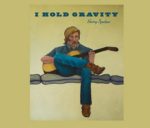 This one’s going to need a little historical perspective; I’ll try to keep it brief. Young guitar-slinger/singer starts to create a buzz in the early seventies, takes half a lifetime out to raise a family but never stops playing and writing, eventually comes out of self-enforced retirement to take up a writing and performing career with his wife, teams up with I See Hawks in L.A. to make an album. The context is important here, because musical influences and stylings that underpin the album from the late sixties/early seventies are married up with stories of rural America. There are little hints of Harry Nilsson, maybe Jim Croce as well in some of the arrangements, but the influences don’t stop at folk and country.
This one’s going to need a little historical perspective; I’ll try to keep it brief. Young guitar-slinger/singer starts to create a buzz in the early seventies, takes half a lifetime out to raise a family but never stops playing and writing, eventually comes out of self-enforced retirement to take up a writing and performing career with his wife, teams up with I See Hawks in L.A. to make an album. The context is important here, because musical influences and stylings that underpin the album from the late sixties/early seventies are married up with stories of rural America. There are little hints of Harry Nilsson, maybe Jim Croce as well in some of the arrangements, but the influences don’t stop at folk and country.
“Be Nemanic” opens up as a barrel-house blues which morphs into a Stax brass-driven stomper (á la Otis and Carla’s “Tramp”) telling the story of the granite-hewn immigrants who helped build the United States; it’s a rousing story of pride and a hint of a warning. There’s a similar raw edge to the opening song “Dirt” but with a raucous chain-gang feel, as the song explores the futility of mineral exploration. There’s a lot of humour in there too in the zydeco-tinged story of two knowing drug mules and the everyday day tale of country jealously, “Mr and Mrs Jones” with a rockabilly beat, some lovely Hammond and some very Steve Cropper-like guitar fills.
The title song, “I Hold Gravity”, is a love song, pure and simple, made achingly poignant by the fact that Gerry’s wife and songwriting partner Susan died as the album was nearing completion and the album’s closer “Into the Mystic” evokes a sense of deep loss before consolation is sought in communion with nature and the desert.
The ten songs on “I Hold Gravity” will pull you through a wide range of emotions. You’ll smile at “God Lubbock”, laugh out loud at “Mr and Mrs Jones”, yearn for the idyllic setting of “Here In the Pass” and cry at “I Hold Gravity” and then you’ll want to put yourself through that emotional wringer all over again; it’s that good.
“I Hold Gravity” is released on Friday June 23.
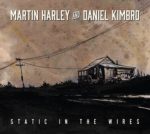 The more I hear of Martin Harley and Daniel Kimbro, the more I realise how perfect the combination is; it was a good day for fans of real music when these guys first met up. Not only are they supremely gifted individuals, but when they play together the total is much more than the sum of the parts. Martin Harley’s developed a well-deserved reputation as a Weissenborn player, but this album constantly reminds you that he has a cracking blues/soul voice that puts him in the top division of singers in that genre. I don’t think Otis Redding’s too fanciful as a comparison, or maybe Frankie Miller if you want something a bit closer to home. And that’s just Martin Harley; Daniel Kimbro’s a master of his craft as well, plucking, bowing, rasping, slapping and generally coaxing some very interesting noises out of his stand-up bass while backing up Martin’s voice with some sweet harmonies. I don’t often look forward to bass solos, but I make an exception in Daniel Kimbro’s case. Every time.
The more I hear of Martin Harley and Daniel Kimbro, the more I realise how perfect the combination is; it was a good day for fans of real music when these guys first met up. Not only are they supremely gifted individuals, but when they play together the total is much more than the sum of the parts. Martin Harley’s developed a well-deserved reputation as a Weissenborn player, but this album constantly reminds you that he has a cracking blues/soul voice that puts him in the top division of singers in that genre. I don’t think Otis Redding’s too fanciful as a comparison, or maybe Frankie Miller if you want something a bit closer to home. And that’s just Martin Harley; Daniel Kimbro’s a master of his craft as well, plucking, bowing, rasping, slapping and generally coaxing some very interesting noises out of his stand-up bass while backing up Martin’s voice with some sweet harmonies. I don’t often look forward to bass solos, but I make an exception in Daniel Kimbro’s case. Every time.
The songs then; they must be the weak point, no? Afraid not; this isn’t just about showcasing some excellent playing, Martin’s writing’s spot-on as well, pulling in influences from all over the world and melding them into authentic twentieth-century roots music that includes love songs like the Southern soul-tinged “My Lover’s Arms” with its lovely guitar fills running through the song and even some honky-tonk piano, and the poetic “Postcard from Hamburg” with lines like ‘The sky’s crying diamonds’.
The honky-tonk feel of the album’s opener, “One-Horse Town” and the uptempo country blues of “Feet Don’t Fail Me” ease you gently in to the album with some lyrical and instrumental invention before giving way to the homesick blues of “Postcard from Hamburg” and the ominous, louring despair of “Gold” and its escape into a soaring solo. I could tell you more about the wizardry of “Dancing on the Rocks” and the claustrophobic atmospherics of “Mean Old City (Part 2)”. I could go on about how good this album is, how it’s a perfect combination of two players (and singers) at the top of their game, and about the great understanding they have and how I don’t understand why people aren’t raving about Martin Harley, but I have a better idea. Instead of taking my word for it, go out and see them on their tour of the UK, Europe and Canada (details on the Martin’s website). That’s better than any recommendation from me, and then you’ll definitely buy the album.
“Static in the Wires” is released in the UK on Friday February 10th on Del Mundo Records.
Our next contributor plays saxophone with Southside Johnny and The Asbury Jukes but also released a strikingly good album this year as part of the New York Horns which is one of Allan’s albums of the year. When we asked him for a High Fives piece, here’s what he came up with. We think you’ll like this.
5 Horn Sections That Changed My Life
As a saxophone player, one of my absolute favorite ways to make music is with other horn players. Give me a trumpet or two, a couple of other saxophone players and a trombone to add some love, and you’ve got a recipe for a whole lotta fun. If the rhythm section is the meat and potatoes, and the vocalist is dessert, then the horn section is the salt. We bring out all the other flavors and make everything oh so much sweeter.
In thinking about the subject matter for this best-of list, it quickly dawned on me that I had MANY more than five examples that I could draw upon to make my point. So many that I almost gave up! After some careful consideration though, here’s five of the horn sections that have changed my life through their contributions to the music:
THE swingin-est band in the history of jazz. Count Basie’s band emerged in the 1930’s in Kansas City, and became the de facto definition of foot-stomping swing with their penchant for shouting blues, riffing head arrangements, and an infectious groove that just made you want to dance. The jazz traditions of “riffing” and “head arrangements”, while not originating with the Basie band, were certainly developed and forwarded onward by the band. Many of the riffs, licks and phrases that you will hear modern horn sections play can trace some or part of their lineage back to the Basie band. Check out “The Atomic Mr. Basie” (1957) and “Count Basie Swings, Joe Williams Sings” (1956). Two of my all time favorite Basie albums.
James Brown redefined popular music. He also redefined the role of the horn section in popular music. Prior to his influence, horns would generally have a more melodic role – playing melodies and generally being in a “lead” role. The late swing and early jump blues bands often were led by horn players and under the vocals the horns played a large supporting role, remaining a mostly harmonic underpinning. James changed all that. The horn section under James Brown became another rhythmic instrument, driving and propelling the groove. With snapping rhythmic pulses and repeating motifs, the horn section was another texture in the rhythm section, adding propulsion and rhythmic intensity. Check out “Mother Popcorn”, “Super Bad”, “Soul Power” and “Cold Sweat” for classic examples. The JB Horns (Maceo Parker, Fred Wesley, Alfred “Pee Wee” Ellis) also were a fixture of P-Funk and Bootsie’s (Collins) Rubber Band, as the Horny Horns.
Growing up in North Carolina, in the southern United States, it was inevitable that I was exposed to the music coming out of Memphis, Tennessee and especially STAX Records. Wayne Jackson and Andrew Love, aka the Memphis Horns, are one of the most recorded horn sections in history. If you’ve heard “Dock Of The Bay”, “Soul Man”, “Hold On I’m Comin’”, “Suspicious Minds”, “Sweet Caroline”, “Takin’ It To The Streets”, “Let’s Stay Together”, “Born Under A Bad Sign”, “Knock On Wood” (and countless other hits), then you’ve heard the Memphis Horns. They appeared on virtually every STAX recording, backing Otis Redding, Sam & Dave, Eddie Floyd, Carla & Rufus Thomas and an endless list of others. Not only were they a staple of the Memphis scene but could also be found as part of the Muscle Shoals scene, and on recordings with Aretha Franklin and Wilson Pickett.
No modern horn player that plays funk, soul or R&B hasn’t heard of or spent time studying TOP. Bursting onto the scene in Oakland, CA in 1968, Tower saw its peak success from 1973 to 1974. The band continues to tour extensively to this day, playing hundreds of shows every year across the world. The horn section has been featured on countless recordings by artists as diverse as Little Feat, Graham Central Station, The Monkees, Santana, Elton John, John Lee Hooker, Rufus, Rod Stewart, Huey Lewis and the News, and Aerosmith and has come to define a punchy, modern and funky style of writing and performing for horns. Check out “Tower of Power” (1973) and “Back to Oakland” (1974) for the definitive TOP experience.
While not a horn section unto himself, Jerry Hey has probably written more horn arrangements for hit songs and albums than anyone else in the business. As part of the Seawind Horns, Jerry was brought to the attention of Quincy Jones. That relationship led to Jerry’s writing for some of the biggest names in the industry. His credits as an arranger include albums from Michael Jackson, Brothers Johnson, Donna Summer, Rufus, George Benson, Patti Austin, James Ingram, Frank Sinatra, Barbra Streisand, Earth, Wind and Fire , Al Jarreau, Chaka Khan, and the list goes on… Two of my favorite albums that feature Jerry’s writing (and the Jerry Hey Horns) extensively are Al Jarreau’s “Jarreau” and “High Crime” (Check out “Imagination”!) and likely my all time favorite Jerry Hey arrangement (and performance) is from Michael Jackson’s “Workin’ Day And Night” (“Off The Wall”).
I could go on and on… there are so many great horn sections, players and writers out there, making incredible music. Hopefully this list will give you some food for thought and a good place to begin to explore the horn section legacy. Enjoy!


